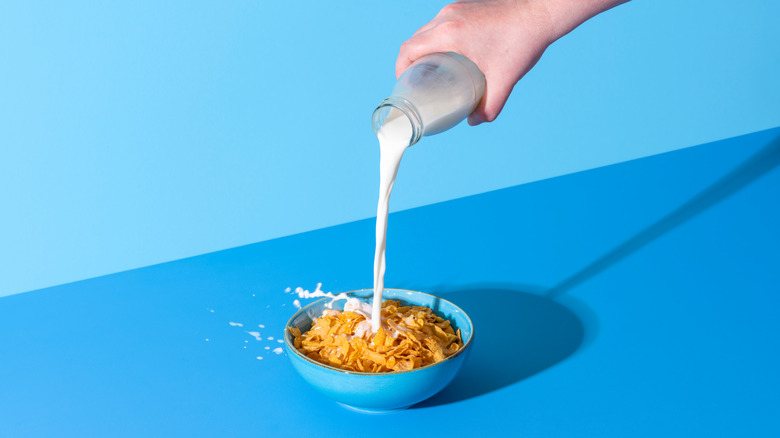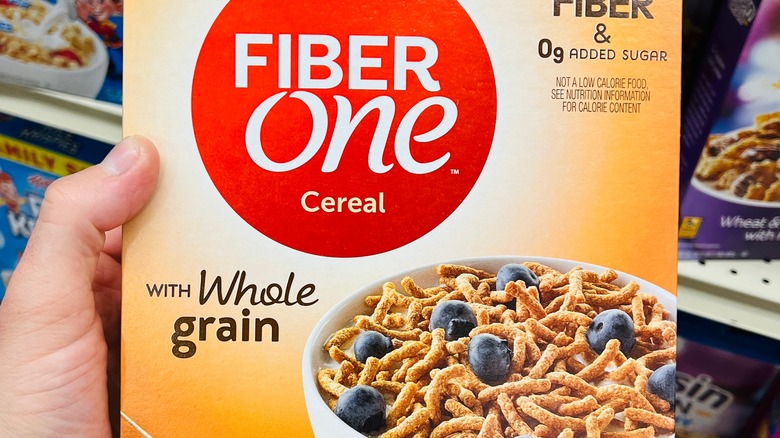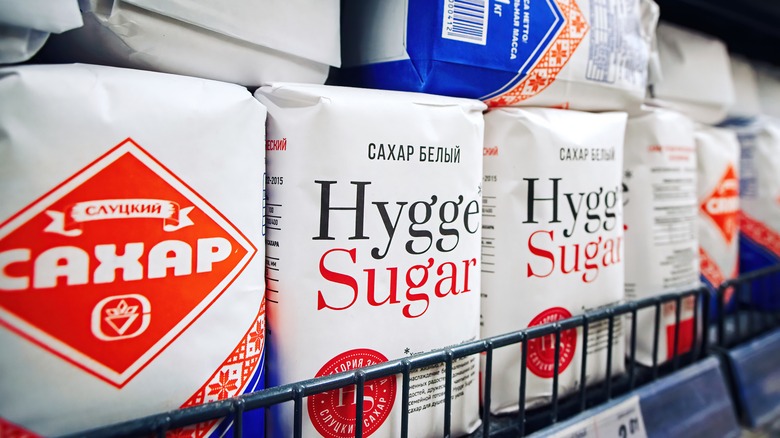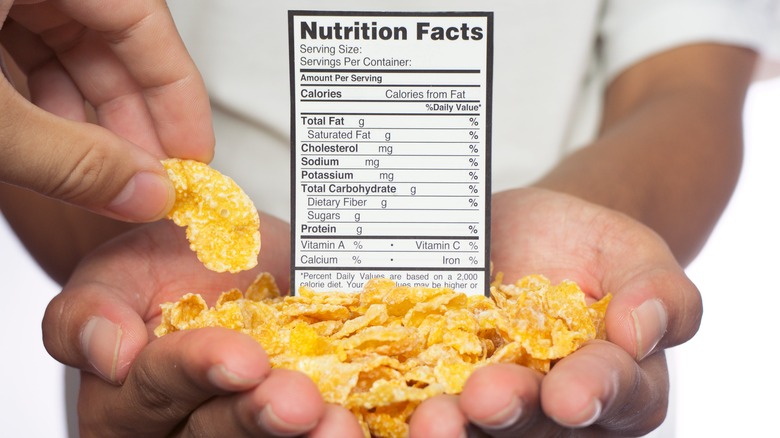Why You Should Always Read The Label On The Cereal Box
You've got your favorites. Whether it's cereals on the sweeter side like Lucky Charms, Cinnamon Toast Crunch, and Fruity Pebbles, or healthier marketed cereals like Special K, Fiber One, and Raisin Bran, odds are, you know what you like, and you're grabbing and going. Cereal is just one of the many things on your long grocery list, and the breakfast aisle is not the most convenient place to stop and read a novel. However, if you knew of all the sneaky tricks cereal companies have up their sleeves in terms of nutrition, you may find yourself scanning the box before throwing it in the cart.
It's important to know what to look for and how to indicate red flags on a nutrition label. According to Vitamin Shoppe, one of the biggest red flags is not being able to pronounce the ingredients on a label. This is a sign of heavily processed food. A typical rule of thumb is to proceed with caution if a label has one foreign ingredient, but if it has more than one, it's best to leave it on the shelf. Thankfully, most cereal labels have legible ingredients, but even ingredients you can pronounce may not benefit you in the way that you think.
Fiber doesn't always mean good fiber
Consumer Reports gives an example of Fiber One cereal, and points out that the ingredient list on the box contains added fibers. It shows that whole grain corn is the first ingredient, which is a good source of fiber. However, the longer down the list you go, you notice ingredients like pea fiber, bleached oat fiber, and added fiber in the form of inulin. It's hard to say how much these additives make up the actual grams of fiber on the nutrition label, and they may not have the same health benefits as fiber from whole grains.
Another important thing to remember is that the ingredients are listed in descending order (via Consumer Reports). So yes, the first ingredient is whole grain corn, meaning that it is the main ingredient, but it's still smart to read your labels to see if that's the only source of fiber. And, just when we thought it all boiled down to the ingredient list, there's more.
Sugar is in disguise
Another way that cereal companies can be quite the tricksters is by sneaking in sugar under different names. You may assume you don't have to watch for added sugars or artificial sweeteners with healthier branded cereals, but some brands might surprise you. According to Insider, a healthy cereal's sugar content should not exceed 10 grams, yet 19.8 grams per serving seems to e the norm. Some sweeter brands that may not shock you are Fruit Loops (15 grams), Cocoa Krispies (14 grams), Frosted Flakes (12 grams), and Cap'n Crunch (12 grams), but some lighter cereals that yield a healthy audience are Raisin Bran, with a whopping 18 grams of sugar, and Apple-Cinnamon Cheerios (13 grams). If you want to know more, here's a helpful list of cereal brands and their sugar content.
Some things to look for besides the grams on the nutrition facts are the sneaky ingredients that may not sound like sugar. Hidden sugars are everywhere, and it's good to recognize them. While the obvious ones are sugar, brown sugar, honey, and caramel, Prevention states that some other words to look out for include corn sweetener, corn syrup, dextrose, fructose, high fructose corn syrup, invert sugar, maltose, malt syrup, molasses, and sucrose. Sugar alcohols and artificial sweeteners are another red flag and are usually labeled as sucralose, aspartame, sorbitol, mannitol, xylitol, maltitol, maltitol syrup, lactitol, and erythritol.
Serving size says it all
Lastly, a key indicator of cereal that's good for you is based on how much of the stuff you can eat. If you notice that a 1 cup serving size yields over 200 calories, it's probably not the best choice. The recommended cereal portion size for adults is 30 grams without milk (via 24/7 Fitness). Cereals vary in density, so this may look different depending on which brand you're consuming, but the ultimate goal is to be able to eat more while consuming minimal calories, without exceeding your sugar intake before leaving the house in the morning. This USDA guide is a go-to on serving sizes and sugar content.
When aiming to shed a few pounds, it may not come naturally to measure your cereal before adding it to a bowl as your first instinct may be to pour straight from the box. But, this could lead to an overconsumption of calories and sugar. Another study by Consumer Reports states how surprisingly small serving sizes are on a cereal box, that is; when you finally notice them.
Now that you've learned the ropes of reading nutrition labels, you'll be on your way to a healthier breakfast choice or, let's face it, eating cereal at any time of the day. Just remember that when you're grocery shopping, it's important to stop, smell the roses, and check the back of the boxes.



